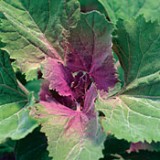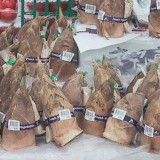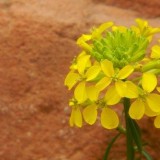 In late February, towards the end of our winter rains, it’s high weed season here in Los Angeles–folks in other parts of the country will have to wait a few more months. We await this season with anticipation, since it’s the best time of year to forage for wild edible weeds. We’ll highlight a few of these edible weeds in the next few months beginning today with Mallow (Malva parviflora also known as cheeseweed because the shape of the fruit resembles a round of cheese), which grows in great abundance in lawns and parkways.
In late February, towards the end of our winter rains, it’s high weed season here in Los Angeles–folks in other parts of the country will have to wait a few more months. We await this season with anticipation, since it’s the best time of year to forage for wild edible weeds. We’ll highlight a few of these edible weeds in the next few months beginning today with Mallow (Malva parviflora also known as cheeseweed because the shape of the fruit resembles a round of cheese), which grows in great abundance in lawns and parkways.
Malva parviflora does not have an especially strong or exciting taste, but does make a pleasant addition to salads and can be cooked as a green. Both the leaves and the immature fruit are edible. An assortment of cooking ideas can be found on Of the Field, maintained by wild food author and self described “environmentarian” Linda Runyan. A Turkish blogger has a recipe for mallow and rice here. We’ve used mallow in salads, and it would also do well cooked Italian style in a pan with olive oil, garlic and some hot peppers to spice it up a bit.
Malva parviflora comes from the old world–the ancient Greeks make it into a green sauce and use the leaves as a substitute for grape leaves for making dolmas. Modern Mexicans also make a green sauce with the leaves. If any of you readers have recipes, please send them along.
If that ain’t enough, the mucilaginous nature of the plant can be exploited by making a decoction of the leaves and roots to use as a shampoo, hair softener, and treatment for dandruff.
And yet, like so many other gardening books, the oh-so-bourgeois Sunset Garden Guide only tells you how to get rid of mallow, and fails to note its many useful qualities.





I picked what I thought might be mallow while I was burying my veggie scraps. But when I compared them to your photo, they’re different. The ones I brought in look sort of similar to yours, but they have 3 sections starting at around the center of the leaf (meaning that the inside section is all connected, but towards the outer half, it starts to separate into 3 sections).
So no wild greens today. But I’m going to watch that area to see if this plant forms cheeseheads, then I’ll guess it’s a different variation of mallow.
There are quite a few related plants in the Malvaceae family that look similar and many are edible. You can read about them on the Plants for a Future database here:
http://www.pfaf.org/database/search_name.php?ALLNAMES=Malvaceae
Unfortunately there are no pictures. Someone needs to do a comprehensive foraging guide book or web site with photos!
I’m looking for Malva for my son’s caterpillars. Any suggestions as to where I can find them near the 60 and 57 freeway? THanks for any input.
Anonymous,
It’s everywhere in the winter and spring. Right now it’s dormant.
Good luck!
I would like to grow mallow in MA, any idea where I can acquire some?
[email protected]
Try the Mother Earth News seed search engine:
http://www.motherearthnews.com/find-seeds-plants.aspx
this plant can accumulate nitrates from the soil due to fertilizer or agricultural runoff, so avoid eating any plants that may have been exposed to excess nitrates.
http://www.fireflyforest.com/flowers/1479/malva-parviflora-cheeseweed-mallow/
BBJAM,
Thanks for the tip. Could be used to get rid of excess nitrates, it would seem.
bena pakistan
anonymus
ya i hav exactly found it here and m working on it
m research scholar,its available in feb march
http://www.weeds.mangrovemountain.net/ruminants.html
This site lists mallow as toxic to ruminants. Do you know why it would be toxic for cattle but safe for humans?
This is the only weed my chickens aren’t eating… if anyone ever wants any, I can’t ever seem to get rid of it and it keeps coming back. I’ll try eating it, but I’m not particularly interested in encouraging it to grow via leaving it there. I just pulled about 100 small plants of it up on Sunday and 20 BIG plants… if anyone is interested I’ll gladly them them have it! Since it didn’t make it into the green waste bin yet.
I’m in Santa Ana.
This is a noxious weed and will take over your flower beds and lawn, to the point that there are thousands–too many to pull.
I rent, so I don’t worry about the lawn or landscaping work at my duplex very much. Well, the landlord came by and asked us to pull all the weeds around the place, so I’ve been trying to find ways to use them instead of just throwing them away. This is one of the most common plants out there! I’m thrilled that I can use the whole plant! Definitely bookmarking this one, and am kinda looking forward to weeding tomorrow, lol! Thanks!
We are overrun with it in a good way; when the rains come on our mountain they threaten to wash all soluble nutrients away (read the dairy manure and rock powders I paid good money for to build up our nutrient-poor soil). So a fraction of the huge amount of malva growing after the summer veggies are frozen out, we eat and sell at local farmers’ markets (they make great chips dehydrated after coating with olive and coconut oil, curry, a bit of salt or bullwhip kelp or tamari, crushed sunflower seeds and nutritional yeast).
The rest we don’t eat has bio-accumulated nutrients for subsequent crops. That nasty deep taproot that makes them hard to pull is also what makes them such great bio-accumulators. After heavy rains I will pull some for composting as we can’t possibly use and sell it all, and some leaves are the size of dinner plates!
The book Edible Wild Plants by John Kallas PhD, Gibbs Smith 2010. The first in what hopefully will be a series with chapters detailing each plant from seedling through maturity, and compares it with common look-alikes. This volume has 15 common “weeds” and planned sequels will have others. This is the best wild plant book I own.
Hey Bill–thanks for the tip–will have to take a look at that book.
My mother has been boiling malva, as a remedy for sores, exma, and other ailments for 70 years. My dad had bed sores on his heals, drs Couldnt fix them, malva did. We drink the tea, and use the leaves on the body.
Angela–Thanks for the tip!
I include the entire plant in a basic cough and bronchitis formula that I have been using for 25 years. The original bronchitis formula, from older editions of the USP and NF, calls for Marsh Mallow, so I substituted Malva p. (or Malva neglecta as I have known it) as I don’t have any Marsh Mallow within my reach. The formula is equally effective with Malva p. I envy those who need to pull it out of their gardens to control its excessive growth – in my garden it has been in the category of plants needing my protection to help it survive.
I noticed malva parviflora sprouting around my chicken coops this year for the first time. I assumed it came as a weedseed along with chicken feed or straw.
I meant to research it sooner because it survives in a tough spot with raw manure and heavy traffic. You have to admire a handsome little plant like that. The chickens won’t eat it. As the fall approached it responded to the cooler temps with a growth spurt and the leaves darkened.
Others have noted it’s a nitrogen accummulator but not much more info about it’s fertilizing abilities. How does it compare to comfrey? Can I encourage it, harvest the leaves as green manure? How many harvests can I produce in a season?
PubMed shows a great deal of research being done now on it’s medical properties.
D’oh! I pulled them all up and threw them in the compost 🙁 what soil conditions does it like? I think the soil where it was growing is pretty alkaline; nothing else seems to be thriving .
Since their deep roots allow them to reach minerals and since they accumulate nitrogen in their leaves, it’s perfect to feed your compost pile with them. Think of Malva as a well pump that draws up deep nutrients and stores them in a handy form for the gardener. Like dandelion and all the docks.
You might try cutting the leaves and placing them around the base of your favored plants. They make a rich composting mulch that way. Mallow won’t spread from the cut leaves so there’s no danger in spreading it this way. Here in NY, in my garden at least, it grows slowly, stays small and is easy to control. The soil I find it in is nearly always well fertilized and pH neutral but compacted clay/loam.
Pingback: weedy wednesday – mallow | yum vee